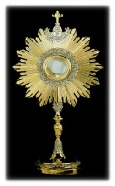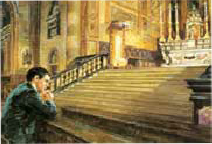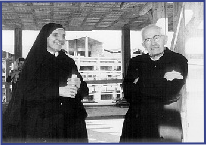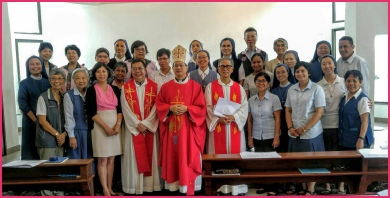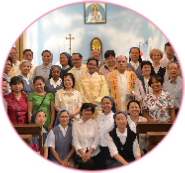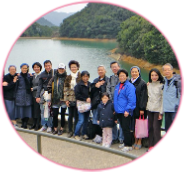





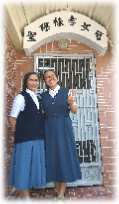
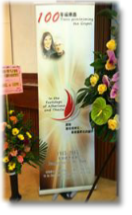
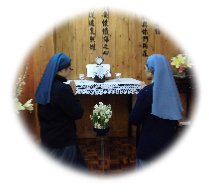
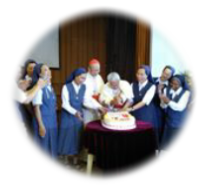
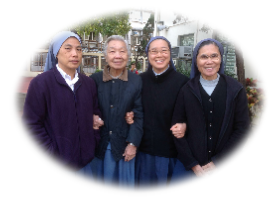



湯漢樞機在「宗教之后堂」講的道理
Dear Brothers and Sisters in the Lord,
I am quite honored and happy to be here today among you to celebrate this Eucharist in the occasion of taking possession of the Church entrusted to me by the Holy Father Benedict XVI, with the title of Cardinal.
Today’s Gospel speaks about the journey of the two disciples of Emmaus, accompanied by the Risen Lord. Today I also join your community on the journey you are carrying on together with the Risen Lord in this Easter period.
Now let me first introduce myself and tell you who I am.
I was born in Hong Kong in 1939. When I was two years old, Japan invaded Hong Kong, then the British Colony. My family fled to Macau and then to Guangzhou, a neighbouring city in South China. There I began my primary school education. Soon after, the Communists started to take over the whole country, gradually. Many wounded soldiers and refugees fled from North China to the South. I saw my parish priest, an American missioner, busy distributing medicine and relief aid to those needy strangers. His compassion was the seed of my own vocation: I felt that I wanted to be a priest like him.
In 1951, together with some other youths, I was brought to Macau to start my priestly formation in the St. Joseph Seminary. Then, I continued it in the South China Regional Seminary in Hong Kong and, later, at the Pontificio Collegio Urbano in Rome. Here I was ordained a priest in the Epiphany of 1966.
After returning from Rome to Hong Kong in 1970, I was asked to teach in the Holy Spirit Seminary. In 1980, when China reopened to the outside world, I was assigned to develop a diocesan program to show the concern of Hong Kong Church for and keep contacts with the re-
In 1992, Cardinal John Baptist Wu appointed me as vicar general of Hong Kong Diocese. In 1996 I was ordained auxiliary bishop, in 2008 I became coadjutor bishop, and in 2009 I succeeded Cardinal Joseph Zen as the ordinary bishop of Hong Kong. This year the Holy Father has honoured me, as well as the Church in Hong Kong and in China, with the title of Cardinal.
Now I would like to share with you my four major concerns as shepherd of Hong Kong Church and as cardinal.
First, evangelization is the prior concern we share in the Diocese. Our Holy Father expects that the Year of Faith, 2012-
My second concern is vocation promotion to the priesthood and religious life.
Happily, each year there are hundreds of lay Catholics taking theology, religious sciences, biblical and catechetical courses. More than a thousand Catholic volunteer to teach Catechesis. But, I do hope that more young Catholics would respond to God’s call for priestly or religious vocations, pushed by the good example of the clergy and Sisters, and that their parents would encourage their children to walk on the path of priesthood and consecrated life.
My third concern is for the non-
My fourth concern is for the Church in China, with which I have been in contact for quite a long time, as I have already mentioned. The recent Supreme Pontiffs have entrusted to the Hong Kong Church the role of being a bridge between the Church in China and the Universal Church. Pope Benedict XVI in making me Cardinal has again encouraged me to carry on this role.
Since China reopened in the late 1970s, its economy is moving very fast toward greater freedom and its progress is quite visible. However, the policies on Religion remain strict. Although there is only one Catholic Church in China, she must face not a few difficulties; the main ones are the control by the government authorities, the limited freedom of action and the disunity among the faithful who need reconciliation.
I briefly describe how I feel about the situation of the Church in China with three simple adjectives: it is wonderful, difficult and possible.
It is wonderful not only for the vitality of the Church and for the growth in number (from 3 millions in 1949 to the present 12 millions), but also for the marvelous examples of courage and zeal by many of her members both in the past and at present. They live in situations similar to those of the early Church and the Holy Spirit raises in them the evangelizing spirit of the two disciples of Emmaus and the courageous evangelical witness of the early apostles.
Let me share with you an episode, which echoes the episode of Philip baptizing the Ethiopian eunuch in Samaria. A priest was put in prison and, since he did not want to join the independent Church, he was punished to lie down with another prisoner on a large wooden board just above the water (the so called ‘water prison’). They had to keep that position for the whole day and this for more days until their resistance would break down. The priest, to overcome the stress and take advantage of that position, spent the time in prayer and in spiritual retreat. His companion, on the contrary, kept complaining and cursing. But seeing the priest quiet and serene, he asked him how he could behave like that. The priest took the chance to explain him the main points of our Catholic faith and doctrine. It turned out to be a catechesis. At the end, the companion pointed out: “As there is water here, what could prevent me from being baptized?” The priest did it as Philip with the Ethiopian eunuch in the Acts of the Apostles.
The Church in China, however, lives in very difficult situations. To understand the challenges she has to face, I would like to quote from a letter of one of my bishop friends on the mainland:
“In every socialist country the government tries to come up with a method: with the cooperation of some nominal Catholics, it sets up another organization outside the Church structure to control the Church herself. The Chinese Catholic Patriotic Association is an example of this.”
The Chinese government pushes towards creating an autonomous National Church, and, through the Patriotic Association tries to achieve this objective, even by means of oppressive ways.
But the situation of the Church in China is still open to great possibilities. Such optimism is founded upon the strong courage the Lord inspires in many Catholics for defending their faith. I again quote the same bishop friend:
“(Facing various campaigns)… the pressure is very great. Regarding myself, I feel that I have been under a lot of strain. However, I have already been through the turmoil of the decades from 1951 to 1979, so I am somewhat indifferent to it.
Everything is in the hands of God. He has arranged everything very well. It will only be for the benefit of the Church.
These overdone activities by the Government to increase its control will definitely not work: rather they will cause the Church to become more aware and more united.
The future is bright; we must quietly await God’s Grace.
The time for this is not very close, nor it is very far away.”
The situation of the Church in China seems depressing, especially if we consider that there are some illegitimate bishops and a dozen among faithful bishops and priests still in prison, but it is not desperate, since the Lord is present and active. Such a situation makes us sad, as the two disciples of Emmaus after having witnessed the crucifixion and the death of Jesus on the cross, but it should also push us to pray for these brethren who are suffering and continue our journey with the Risen Lord in an attitude of communion and solidarity.
I conclude by asking from the Lord the most abundant blessings upon the clergy and the community of Mary Queen of the Apostle Parish, which now I also can call “my parish” in Rome. May the Lord bless you and your families!

香港聖保祿孝女會很高興,教宗本篤十六世委任湯漢樞機為我們「宗教之后堂」的領銜主教。所有新樞機都獲委派名義上領導羅馬一座教堂,以凸顯普世教會跟樞機之間的緊密關係。
這代表湯漢樞機現在是我們「宗教之后堂」的教區主教,但只屬領銜性質。教堂內一處刻了他的 姓名,並掛起他的牧徽。

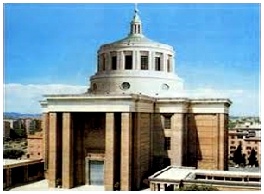
 中文
English
中文
English



| 我們的伊始 |
| 更認識我們 |
| 我們的會祖 |
| 戴格蘭修女 |
| 聖保祿大家庭 |
| 家庭共聚 |
| 書籍 |
| CD |
| DVD |
| 心意卡 |
| 海報 |
| 聖物 |
| 書展 |
| 福傳活動 |
| 贊助會概覽 |
| 里程碑 |
| 靈修培育 |
| 福傳拓展 |
| 會員分享 |
| 李修女文件夾 |
| 徐修女迭事貼 |
| 贊助會員分享 |
| 更多分享 |
| 香港 |
| 世界各地 |
